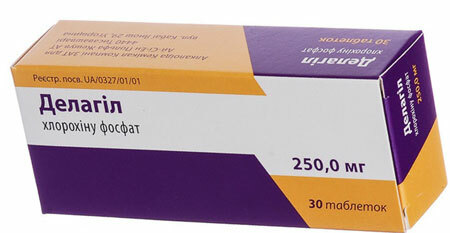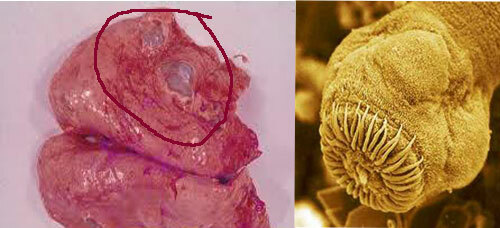( Toxoplasmosis) What is it? Toxoplasmosis is a parasitic disease from the "kingdom" of infections, a class of zoonoses. It is caused by a toxoplasmosis gondilla, a microorganism leading the parasitization inside the cells. Developing inside the body, violates many functions of human organs and systems. The disease differs polymorphic( manifold) and asymptomatic clinical picture.
Genesis of the disease
The parasite is able to live in the body of a wide variety of bird species and mammalian fauna species, to penetrate into cells and any tissue structures. Stages of ontogenesis of the pathogen are due to several stages of development - schizogony, stages of budding and reproduction, sporogony.
All stages of development take place in different environments, but the full cycle of development, the oocyst( parasite) takes place in the tissues of the cat and its organs. As a result of feces, the parasite enters the environment, where it can survive in the form of cysts for 1.5 years. Accordingly, toxoplasmosis in humans can appear:
- After eating poorly processed meat products, infected with cysts toxoplasm;
- By means of seeded with a causative agent of greenery, unwashed fruit and berries;
- In case of contact with a skin catheter or mucous membrane of saliva, urine or tear fluid of an infected cat.
An infected person is not dangerous to others, as it does not isolate the pathogen in the external environment and does not transmit it in intimate proximity. In addition, not all infected must necessarily be treated. If the human body infected with toxoplasmosis has a strong immunity - it is not very vulnerable.
Infection can be transmitted only during transplantation operations, if the donor has a disease in its primary form, or congenital( intrauterine - through the placenta).
Content
- 1 symptoms of toxoplasmosis in humans
- 1.1 Congenital( congenital) toxoplasmosis
- 2 Features toxoplasmosis in children
- 3 Toxoplasmosis and Pregnancy
- 4 Treatment of toxoplasmosis in humans
- 4.1 Complications toxoplasmosis
- 4.2 Preventive measures
symptoms of toxoplasmosis in

human latent infection period - uptwo weeks. Symptoms of toxoplasmosis in man in the initial period of the disease are almost not manifested, or pass unnoticed.
The pathogenesis of the disease determines its character - acquired or congenital, manifested by acute course, chronic and latent.
The acute course of is characterized by a sudden onset with marked symptoms of intoxication and fever, possible manifestation of hepatomegaly( enlarged liver) and splenomegaly( enlarged spleen).Sometimes there are skin rashes, signs of encephalitis and meningoencephalitis.
The current is heavy. Complicated by focal or widespread inflammatory reactions of the myocardium, a symptomatic manifestation of psychoneurological and cognitive functional disorders( memory, mental functions, etc.) often with a fatal outcome.
The chronic course of the is characterized by a prolonged sluggish picture. Sometimes with asymptomatic course, or with gradually increasing symptoms.
- Prolonged subfebrile temperature( month or more).
- Chronic course of intoxication.
- Increase in a large group of peripheral and mesenteric lymph nodes. When palpating, they are initially soft and painful, over time, soreness goes away, they decrease, but their structure becomes dense.
- Muscle and joint pain - with muscular lesions, in addition to inflammatory processes, the muscular tissues are probed for painful condensed zones, caused by the formation of calcifications.
- Dysfunction of the gastrointestinal tract with the manifestation of intoxication, xerostamia( dry mouth), apathy towards food, pain syndrome in the epigastric zone, constipation and weight loss.
- Symptoms of CNS damage( convulsions, seizures, hysteria, imbalance and suspiciousness).
- The violation of visual functions is the development of progressive myopia.
- Failure in endocrine functions - impotence, decreased functions of the thyroid and adrenal glands, changes in the menstrual cycle.
- In more than half of patients with chronic toxoplasmosis, hepatomegaly and splenomegaly are diagnosed. On palpation, the liver responds with pain. Significantly manifested is its functional pathology.
- From the side of cardiac disorders, there are signs of tachycardia, heart pain, lowering of blood pressure.
With the latent flow of , even a thorough diagnosis can detect only residual old signs of sclerosed foci of lymph nodes or calcifications in the muscle tissue. Confirm the diagnosis can only PRC study, or intradermal test for antibodies to toxoplasmosis.
Congenital( congenital) toxoplasmosis

Toxoplasma gondii Toxoplasma( photo)
This form of the disease is relatively rare. It develops during placental infection with toxoplasma during the period of gestation. In acute current manifested in toddlers:
- feverish condition;
- severe intoxication;
- with hepatomegaly and splenomegaly;
- possible attachment of mechanical jaundice;
- skin rashes and ocular pathologies;
- severe symptomatic of brain damage.
Congenital toxoplasmosis of chronic stage is dangerous - it threatens with severe manifestations of inflammatory processes in the brain - development of mental retardation in the child, dropsy of the brain, manifestation of various focal seizures of epilepsy.
Features of toxoplasmosis in children
The latent period of infection in children lasts from 3 days to 3 weeks, but may continue for several months. Everything depends on the degree of infectivity of the pathogen, the degree of damage, the previous conditions.
Begins usually acutely, with very high fever or previous malaise, minor headaches and general weakness.
In acute process, symptomatology is aggravated. Add joint and muscle pains, chills, children lose their appetite and quickly lose weight. Skin rashes have the appearance of spotted-papular fusions, forming spots with wavy, jagged edges.
Eruptions are localized throughout the body, but do not cover the skin of the foot, palm and head.
Characteristic increase in cervical, axillary and inguinal lymph nodes. Sometimes inflammation and enlargement of the lymph nodes are noted in the zones of the peritoneum and mediastinum.
Toxoplasmosis and pregnancy

Toxoplasmosis in pregnancy, basically has an asymptomatic course and can only be determined with an appropriate examination. In rare cases, migraines, lymphadenitis, a slight subfebrile condition and cold symptoms are possible, which is often regarded as a cold.
With chronic pathology, signs of neurologic disorders, decreased visual functions, gynecological and internal injuries are added to the common infection symptoms. Severe infection is accompanied by skin rashes, febrile condition, tenderness of muscles and joints.
Infection, transferred before pregnancy, to women in the situation is no longer terrible - it is formed by immune protection.
If nevertheless the future mothers have primary infection - then toxoplasmosis destroys its destructive abilities, first of all, it will bring down on the child. The severity and severity of violations is directly related to the period of pregnancy. The higher it is, the greater the chance for the child to be born healthy, without any pathologies. The disease can be in the form of latency and manifest in many months or years.
It can not be unequivocally asserted that toxoplasm during pregnancy is a definitive indication for abortion. But, if a typical maternal antibody is found in her mother's examination, a thorough examination is necessary - in the presence of infection in the amniotic fluid, the risk of pathological damage to the fetus is very high.
And here it is necessary to make a choice - to treat or interrupt pregnancy. After all, to treat infectious pathology during pregnancy, begin only on the fourth month of pregnancy. Antibiotics are used in the treatment, so that both in infection and in treatment, the negative factor is very high.
It's not for nothing that doctors advise to terminate a pregnancy if the period is less than 6 months. The only positive nuance - in the subsequent pregnancy such an infection is not dangerous - the immunity has already "built a defense."
Treatment of toxoplasmosis in humans
The diagnostic criteria for this infection are only two - a polymerase reaction based on the body's ability to produce special antibodies to fight infection. This method reveals the DNA of the pathogen. And also IFA method( immunoenzymatic).By the biochemical reaction, the presence of protein components of immunoglobulin with antibodies "M" and "G" in the blood is determined.
The production of "M" antibodies in the body starts from the first day of infection and lasts up to 3 weeks. After that they can disappear. Therefore, if immunoglobulins with this class of antibodies - IgM - are detected in the blood, this is a confirmation of the infection and is acute.
An unusual norm for the analysis of toxoplasmosis is the detection of antibodies( Ig) in the blood with the antigen "G" -( IgG).That testifies about the infection transferred earlier and about the presence of immunity to it.
An additional diagnostic method may be an intradermal allergy test with toxo-plasmin. A negative test confirms the presence of infection and allows to identify its chronic form. Positive test, shows a good reaction of the body and well-pronounced immunity.

Treatment of toxoplasmosis in humans is aimed at stopping the infectiousness of the pathogen. Includes complex therapy - etiotropic, symptomatic, pathogenetic and immunostimulating drugs.
- In case of acute manifestation, the combination of preparations of "Sulfadimezin" with "Chloridinamine", "Aminochilon", preparations of sulfonamides and antibiotics of tetracycline group. With individually selected treatment program.
- In chronic course, complex therapy is prescribed - "Tetracyclines", antiallergic and immunostimulating drugs( Delagil and analogues), vitamin complexes, immunoprophylaxis with toxo-plasmin.
With confirmed reactions, but without visible symptoms of toxoplasma in pregnant women, treatment is not performed. With a new infection, a two-time course of simultaneous administration of "Sulfadimezin" and "Chloridin" is prescribed. But, treatment is possible only in the second trimester of pregnancy, which is due to harmful effects on the fetus.
Complications of toxoplasmosis
In general, complications occur in patients with weakened immunity and with congenital disease. It is especially hard for her to be infected with HIV and AIDS patients. They have to be treated throughout their lives. The most common complications are:
- seizures and focal neurological disorders;
- complete, or partial blindness;
- by partial paresis and paralysis;
- endocarditis, myocarditis and arachnoiditis;
- pneumonia and infectious-toxic shock.
Prevention measures
Prevention measures for toxoplasmosis are fairly simple, you just need to exclude causative factors - limit contact with cats, observe hygiene, and carefully heat the meat and milk before eating.
Especially these rules are relevant in pregnancy.



